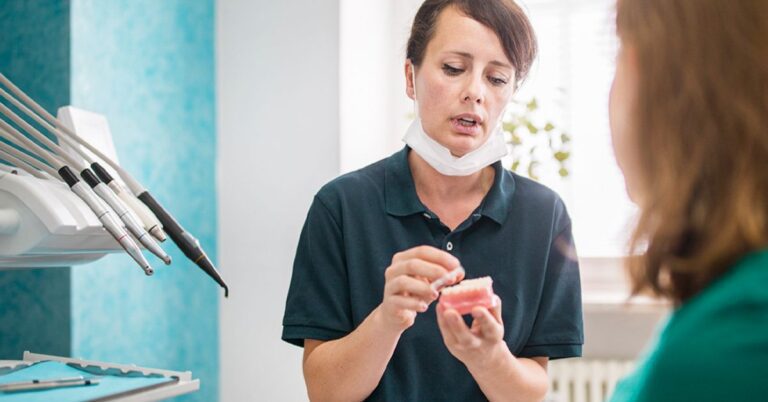A temporary crown is a tooth-shaped cap that protects a natural tooth or implant until your permanent crown can be fabricated and secured in place.
Because temporary crowns are more sensitive than permanent crowns, it is important to take extra care when flossing or chewing while a temporary crown is in place.
Read on to learn more about why you might need a temporary crown and how to make sure it doesn’t break or loosen before it’s replaced with a permanent one.
Temporary crowns are used when a natural tooth requires a traditional permanent crown.
Because a permanent crown takes a few weeks to be made to your specifications, your dentist will place a temporary crown until the permanent crown is ready.
A temporary crown is used to:
- protect the natural tooth (or implant site) and gums
- allow you to smile normally without a gap
- reduce tooth or gum sensitivity
- keep the proper distance between your teeth
- helps you chew and eat
- help the dentist estimate how the crown will work
A temporary crown can cover an implant or a tooth with a root canal or a tooth that has been repaired. It can be used for any single tooth or it can be a bridge over more than one implant or teeth.
Some dental offices may have the skill and computer equipment to make a crown in one day, but in most cases it will take at least a week or two to create a permanent crown.
Your temporary crown will likely stay in place for 2 to 3 weeks or longer.
How long you have the temporary crown in depends on the extent of dental work required.
Implants, for example, can take a few weeks to several months for the bone to heal before a permanent crown can be placed over them.
The shape and color of your temporary crown will be similar to your natural teeth.
Your dentist can use computer imaging technology to choose a shape for the permanent crown that will fit your mouth perfectly. Or the dentist will take an impression of your existing teeth as a guide for making the permanent crown.
Your dentist will also carefully match the shade of your permanent crown to that of your other teeth.
But the temporary crown may not be that perfect, mainly because it’s not meant to stay in place for more than a few weeks. Also, the color may not match your other teeth as well because of the materials used for a temporary crown.
Your temporary crown is attached with temporary cement. It should be fully functional so you can chew normally. However, because the glue is not meant to hold the tooth in place permanently, it is best to avoid chewing hard, tough or sticky foods.
It is also a good idea to avoid sugary foods. Your temporary crown may have a gap between the crown and the gum line. This means that sugar could find its way under the crown and cause wear.
Here are some foods to avoid while you have a temporary crown:
- steak or tough meat
- hard or crusty bread or bagels
- hard or crunchy fresh vegetables, such as raw baby carrots
- hard or crunchy fresh fruit, such as apples
- corn on the cob
- chewing gum
- pop corn
- nuts
- hard candy
- caramel
- ice
Also try to avoid very hot or very cold foods, which can affect how well the cement holds the temporary crown in place.
Caring for your temporary crown requires a little extra care.
You will need to be careful when flossing to avoid dislodging the temporary crown. Try gently pulling the thread in and out, rather than pulling it down.
You may also need to brush the area more gently.
It is important to maintain your oral hygiene routine and keep the area around your temporary crown clean.
The best thing to do if your temporary crown comes off is to call your dentist for an appointment to reattach the temporary. The same applies if your temporary one is lost. Your dentist is likely to replace it with another temporary crown.
It is important not to leave the space in your mouth empty, because the tooth or gums under the crown can be damaged or infected. It can also throw off your bite, causing problems with permanent restoration.
Crowns – both temporary and permanent – are an investment in the health and proper functioning of your mouth. Keeping the temp in place protects your investment.
A temporary crown is designed to be a placeholder until the permanent crown is created and fixed in place. It will look like your other teeth, although it won’t match your teeth exactly like your permanent crown will.
The temporary is not as strong as a permanent crown, so you have to be a little more careful.
Avoid biting down on hard or sticky foods and floss and brush gently.


